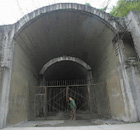-
-
China Daily E-paper
From overseas press
Costs, new risk profiles test big city security
(Agencies)
Updated: 2010-04-01 09:40
 |
Large Medium Small |
Editor's note: The bombing of Moscow's metro has underscored the need for tighter security on public transport, but pressure on national budgets and growing problems identifying would-be bombers will make a tough task even harder.
Transport authorities are seeking more sophisticated methods of monitoring passengers to prevent attacks, but there are no easy ways to shield the world's cities and their crowded places from people set on blowing themselves up, analysts say.
Like the gas attacks on Tokyo's subway in 1995, train bombings in Madrid in 2004 or bombings on the London Underground in 2005, the Moscow blasts, which killed 39, highlighted the vulnerability of systems moving millions of passengers a day.
Imposing airport-style passenger and bag checks in the metros and bus stops of major cities is impractical because it would bring ordinary life to a halt.
The challenge has been made more difficult by a recession-driven squeeze on budgets, and the increasingly unpredictable backgrounds of would-be attackers, a trend that makes it harder for targeted "profiling" surveillance to spot assailants before they strike.
Yvan De Mesmaeker, Secretary General of the European Corporate Security Association told Reuters he was not optimistic that a solution to public transport security was near.
"It's really a dilemma. You cannot apply airport measures because the delays it would create would be impossible. And we do not have a technological 'wonder system' that can easily detect illegal materials in mass transit."
"What we can do, as they do in Israel, is to have citizens who are aware and vigilant and willing to report information. They are the eyes and ears of security."
Below are the main areas that security experts are focused on when seeking ways to detect and minimize the impact of attacks.
TECHNOLOGY
Security is about creating layers of protection, and at a train station for example that means putting as much time and distance between a bomber and the target as possible. Layered security barriers are an example.
Layering gives authorities valuable moments to spot a risk and intervene, said Tobias Feakin, Director of National Security and Resilience at the Royal United Services Institute in London.
But explosives detection remains a problem in mass transit.
"The problem with many detection technologies in development is that they simply cannot cope with the volumes of people passing through," Feakin said.
Existing CCTV surveillance technology is far more useful in investigations after the fact than it is in preventing attacks. It can be a deterrent for ordinary criminals or amateurish militant groups, but is not for committed suicide attackers.
Feakin said security companies were researching ways to link CCTV surveillance to facial recognition programs to enable the police to spot a wanted person in real time, or to check for expressions or body language indicating stress.
"If you end up getting 'false positive' detections on stress, that may be the price we have to pay," he said.
John Tyrer, Professor of Optical Instrumentation Britain's Loughborough University, said new technologies were emerging able to detect explosive residue among people streaming into train or bus stations, but it was not cheap.
In one case, a detector covering an entrance hallway at a bus station would cost about 100,000 pounds ($150,000), he said.
"Traditional CCTV is passive. We need much more intelligent instrumentation that can get the explosive residue on a person to light up and say 'I'm here'."
PROFILING
One challenge is that militants are recruiting a more diverse set of attackers than ever before.
Western-based women converts to Islam, for example, have enlisted in plots by al Qaeda-aligned groups to attack Western targets, according to law enforcement officials.
In a recent case in the United States, Colleen LaRose, who used the online pseudonym "Jihad Jane," told co-conspirators her appearance as a blonde-haired white woman would allow her to "blend in with many people" and avoid being detected as an Islamic terrorist, the indictment said.
She is accused of plotting with others over the Internet to kill a Swedish cartoonist who depicted the Prophet Mohammed in a way that was offensive to Muslims.
"The more cases you get, the more diverse the profile is. This raises serious questions about profiling," said Jeremy Binnie, Editor of Jane's Terrorism and Security Monitor.
"I'm not even too sure about how suspicious people look. With suicide bombers the record shows that they do not all behave strangely or start sweating or fidgeting in the moments before an attack. Some are in a calm, meditative state."
DESIGN
A variant of security technology that is drawing increasing attention: The British government recently published guidance for local authorities on making crowded places safer.
The document gives advice on counter-terrorism design principles including better blast resistance, better building management facilities and better traffic management and prevention of vehicle-borne explosives.









